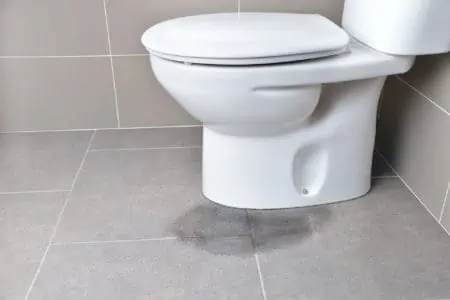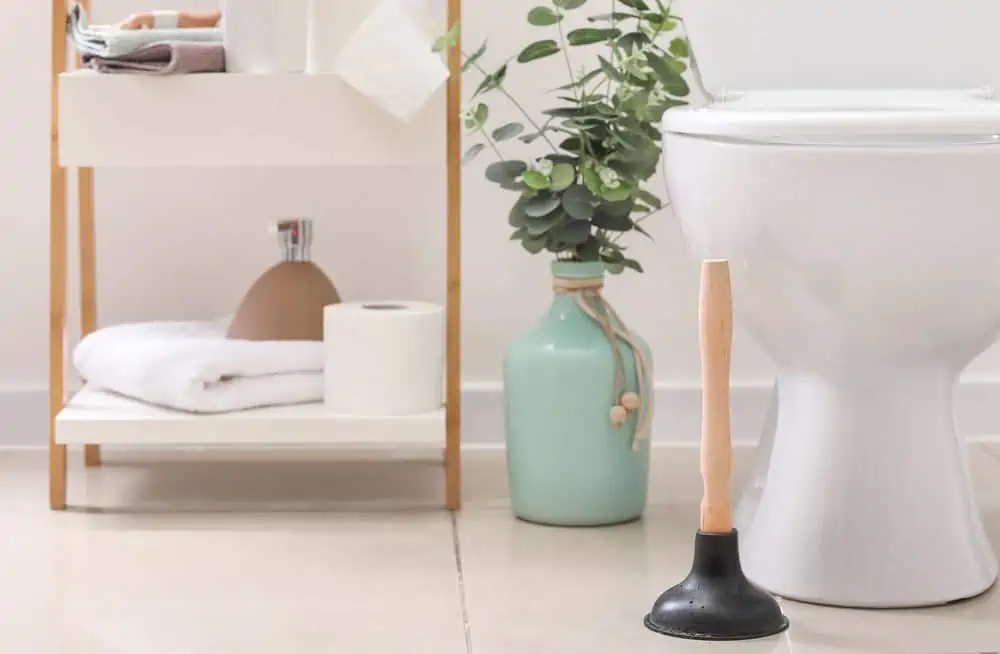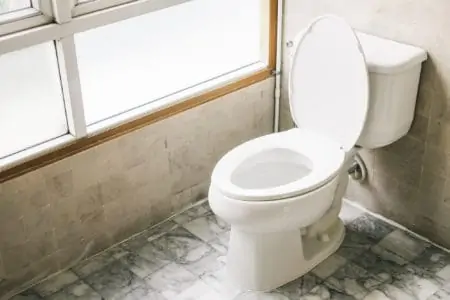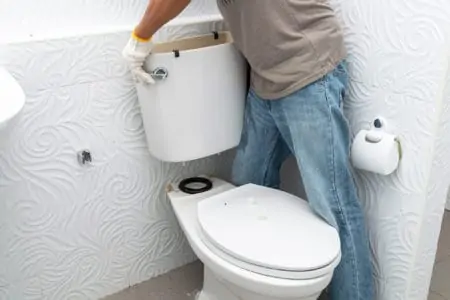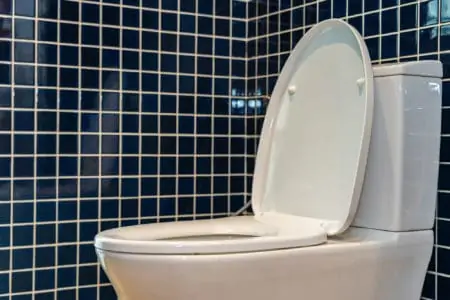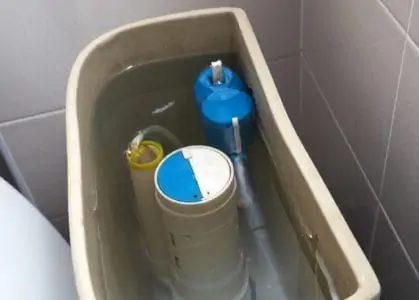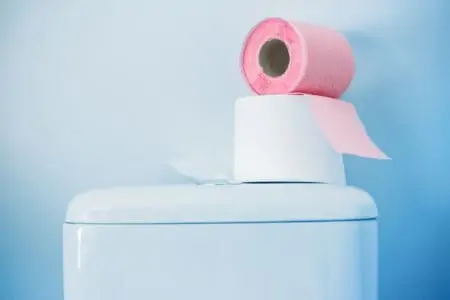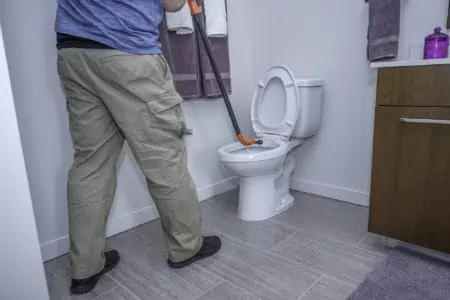Knowing how to tell if your toilet is leaking underneath can be tricky. When the problem becomes apparent, it’s probably already out of control. It is likely that the damage is significant, but luckily, it is repairable.
So, if you’ve got a toilet leaking from the bottom, we’ll explain the likely causes and tell you what you can do to solve the problem.
Key Takeaways
- Signs of a toilet leak include water pooling at the base, damp ceilings, sewer gas smell, and unusual toilet sounds.
- Common causes of leaks are loose T-bolts, wax ring problems, cracked toilet bowls, and fill valve issues.
- Ignoring a leak can lead to structural damage, mold growth, and costly repairs.
- Fixing leaks early can save time and money, so address any signs of leaks as soon as possible.
Can Your Toilet Leak Without You Knowing?
You know it’s bad when you’re indoors and feel water dripping on your head. Your toilet could be leaking for several days or even weeks before the issue becomes apparent. The toilet is bolted to the floor via a flange, making spotting leaks challenging.
According to the International Plumbing Code, you should caulk your toilet to the floor, but this also makes it tricky to spot leaking water.
Often, you only spot the leak when it makes the bathroom floor feel spongy because rot or water starts to stain the ceiling of the room below.
How to Tell if a Toilet is Leaking Underneath
If you get wet feet when you sit down to pee, it is likely because you have pooling water at your toilet’s base. While it may take some time to become apparent, water always finds a way out.
You may also have a spongy floor, thanks to water rotting the wooden joists and supports. A rotten under floor is a serious problem because it affects the room’s structural integrity. It’s also one of the most expensive fixes because the entire rotted section needs to be removed.
The ceiling in the room below the toilet typically stains as the water saturates the drywall and woodwork. If you don’t stop the leak, it could cause the ceiling to come down.
If drywall gets saturated, it falls apart. After all, it is only plaster of Paris sandwiched between sheets of paper. One easy way to check if your toilet leaks is to add a colored food dye to the tank. If the color of the bowl water changes without flushing, you have a problem.
While the dye method won’t tell you if you have a leak from the bottom of your toilet, it will tell you if you have a leaky tank.
Signs of a Leaking Toilet
If you spot water pooling around your toilet’s base, get your toolkit out straight away because it’s likely that the leak is a few weeks old.
Here are the tell-tale signs that you have a problem:
Water Under the Bowl
If you spot water pooling at the base, you probably have a leak. Leaks occur when the wax ring becomes loose, and water flows from the bottom of your toilet. There are several causes, like a broken wax ring, faulty flange, or even a cracked toilet bowl.
The only solution is to drain the water from the toilet and remove it. Doing this exposes the flange and wax ring so that you can determine what is causing the leak.
Water Under the Tank
Feeling around the toilet bowl reveals if you have a leaking seal between the tank and the toilet. You can confirm you have a leak by adding this Watkins colored dye to the tank water and seeing if the bowl water changes color.
If left unchecked, this seal could eventually come back to haunt you. Water could leak outside of the tank.
Damp Ceiling
Ceilings are typically drywall, which sucks up moisture like a sponge. As the drywall becomes saturated, it starts to change color. Look up at the ceiling and check for water stains.
It could mean an expensive repair job because the damp drywall needs to come down. You may also have rotted wood beneath, which is bad news for your wallet.
If left unchecked, water will come through the ceiling, and eventually, it will collapse.
Smell of Sewer Gas
If you’ve noticed a pungent smell in the bathroom and have been blaming your partner, it may be something else. Foul-smelling sewer gasses seep into your home when the wax ring fails.
It could also mean water leakage because the wax ring is supposed to prevent water seepage from the sewer pipe. You will need to drain the toilet and remove it to reveal the secrets beneath.
Also, if your toilet rocks when you sit down, it could be another sign of a faulty wax ring.
Safety Note
While the sewer smells are unpleasant, there is also a health risk because it contaminates the air with hazardous pollutants.
Toilet Sounds
If you notice your toilet making strange sounds when flushed, or you can hear water running when it is idle, it could be a fault. When water flows from the tank without flushing, the seal between the toilet and tank is broken and needs replacing.
You could grab a Sharpie pen, make a mark to indicate the waterline, and watch to see if it drops. Also, if your toilet bowl gurgles, it could mean you have a blockage, and that water is looking for a way out.
Stain Around the Base of the Toilet
If the base of your toilet has staining, it could mean water is seeping through and rotting the wood beneath. It’s worth remembering that wood soaks up water like a sponge and only releases moisture when it’s saturated.
One tell-tale sign is a spongy floor around the toilet’s base. Get on your hands and knees and feel for damp patches. Unless someone has a poor aim, there’s a strong chance your toilet is leaking from beneath.
Also, check the room below to see if water is coming through the ceiling.
What Causes a Toilet to Leak from the Bottom
So, we’ve looked at the tell-tale signs of a water leak, but what causes the water to seep out in the first place? Let’s check out the common culprits:
Loose T-Bolts
T-bolts secure the toilet base to the flange and floor. Over time, the bolts work loose, making the toilet wobble and move when you sit down. Grab an adjustable wrench and give the bolts a tighten, and the problem is cured.
Take Care
Don’t over-tighten the bolts because you risk cracking the porcelain.
Wax Ring Problem
The wax ring sits beneath the toilet and seals the sewer pipe to the flange. Wax is malleable, so it molds to your toilet and sewer pipe shape. It cracks and splits when it dries out, revealing gaps that allow brown liquid to leak out.
If your wax ring has malfunctioned, you might also notice sewer smells lingering around your toilet. Fixing a broken wax ring is simple but labor-intensive. You will need to isolate the water supply and drain the toilet.
Once empty, remove the bolts clamping the toilet to the flange, and lift the toilet free. The wax ring sits between the waste pipe and your toilet’s base and must be removed.
You can do this with a putty knife to scrape the wax away. You will then need a new wax ring before you replace the toilet.
Cracked Toilet Bowl
If you have a cracked toilet bowl, the best solution is to replace the toilet. You can perform a temporary fix using Pro Marine epoxy resin, but it will only last for a while.
To determine if you have a cracked bowl, run your hands over the exterior of the toilet to feel for hairline cracks and chips. If you feel wet patches, you likely have a fracture in the bowl.
Take Note
If the toilet bowl is cracked, it could lead to further problems if left untreated. The damage occurred for a reason and may indicate weak porcelain.
You will need to drain the system, remove the toilet, and install a new one to fix the issue.
Fill Valve Problem
The biggest sign of an issue is when the toilet fails to flush or water runs continuously. The fill valve sits inside your toilet tank and raises and lowers every time you flush. Without it, your toilet wouldn’t function.
In most cases, the flapper and lift chain are prime suspects. If the chain is too long, it fails to lift the flapper and doesn’t flush. Too short, and the flapper won’t seal the opening to stop the water from flowing into the bowl.
They are easy to fix. You can buy replacement chains and remove links to gauge the right length. Some chains come complete with a flapper. This Essential Value Toto Flapper and Chain is an excellent example.
If your toilet has the canister version of the fill valve, it is better to replace the entire valve rather than trying to fix it. This Fluid Master Fill Valve is another excellent example of what is available online.
FAQs
The Last Word
Minor problems are easy to fix, especially when you catch them early. Unfortunately, spotting a leak beneath your toilet may take longer because the signs are less noticeable. However, once you detect a leak, act on it immediately to minimize the damage.
It could be the difference between spending a little and spending a lot.
